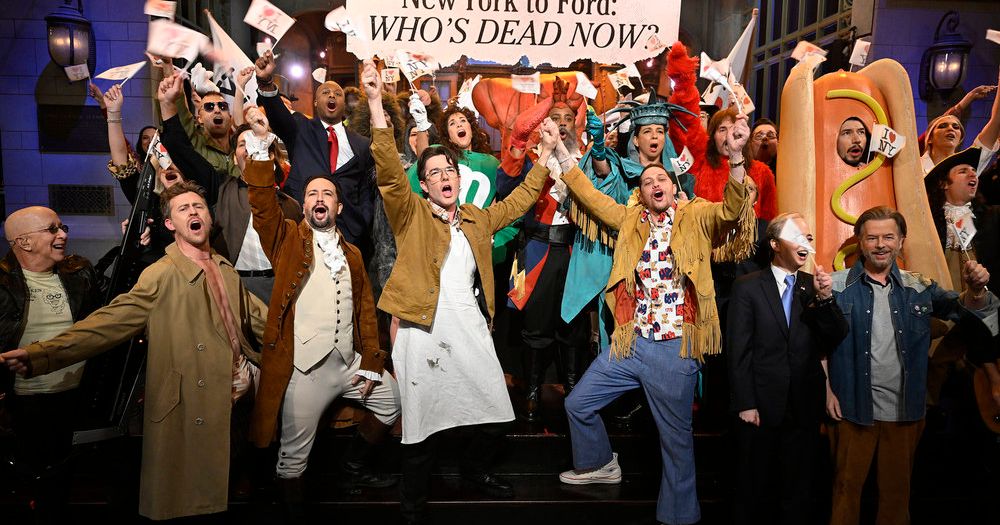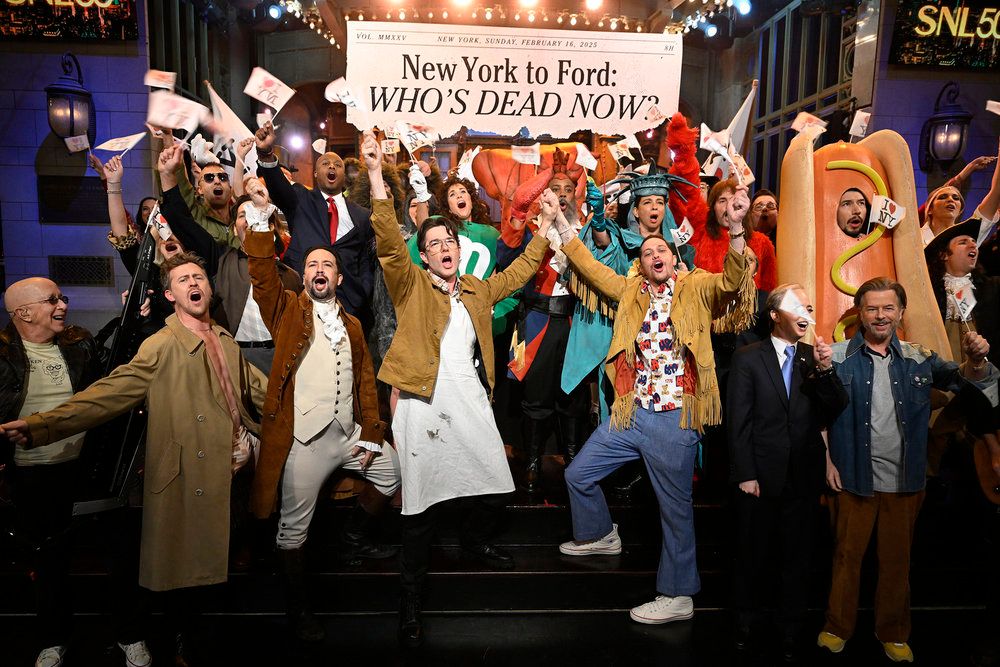SNL50 Recap: This One’s For the Millennials
The 50th-anniversary special found clever, reverential ways to play in the deep sandbox of SNL’s past, but especially the late ’90s and aughts.


Watching any entrenched institution pay slobbery tribute to itself can be insufferable. (See: Oscars, The.) Saturday Night Live hitting the half-century mark, however, is an occasion that absolutely warrants some self-celebration. Thankfully, SNL50’s creators pulled out all the stops to make what could all too easily have been a masturbatory exercise into something that should satisfy just about everyone — but especially millennials.
SNL50 had three jobs: capture the significance of the milestone, pay respect to those who made it possible, and be funny. It handily managed all three, often at once. The monumental nature of the event had already been telegraphed exhaustively—starting with promos during NBC’s Olympics coverage last summer and culminating in a full-scale assault of docs and side-specials in recent days—but it bears repeating. SNL is not just a joke factory and musical showcase, but a record for posterity. It’s a living, breathing museum of American history, forged in the ever-unfurling present, revealing how people at any given moment talked, dressed, and shopped; which movies and commercials they watched; and the kind of jokes they found funny. It is well and truly remarkable that this archive now spans 50 years. Kicking off the show with a withered Paul Simon, part of the SNL family since the beginning, and a fresh-faced Sabrina Carpenter, whom many of us had never heard of a year ago but who already feels etched into pop culture firmament, captures both how far back SNL stretches and how it’s always on now.
As for the “be funny” edict, Lorne Michaels wasn’t taking any chances. To write the show, he enlisted an Avengers of legendary SNL scribes, including Tina Fey, Jim Downey, Paula Pell, Seth Meyers, and John Mulaney. Freed from the demands of a typical episode, in which whatever Donald Trump happened to say that morning could upend entire sketches, the team found clever, reverential ways to play in the deep sandbox of SNL’s past and present.
Lorne reportedly remembered the 40th-anniversary special in 2015 as a perfect show, and asked Fey to study it. Given how SNL 50 turned out, that tracks. The other previous mega-special, SNL’s 25th-anniversary show from the year 2000, over-indexed on the early years, perhaps necessarily, but otherwise spread out its sketches and homages as evenly as possible (way easier to do with a period of 25 years instead of 50). In contrast, the 40th-anniversary show minimized the early years and instead explored the fun possibilities of intergenerational cross-pollination. Rather than just having Billy Crystal’s Fernando or Bill Murray’s Nick the Lounge Singer do crowd work, as the 25th special did, the 40th plugged original cast member Laraine Newman into a contemporary Californians sketch—which ended with the meta-joke of David Spade’s ’90s flight attendant buh-bye-ing the performers as they exited the sketch.
It was like fantasy football but for SNL—seeing how it might turn out to draft Cecily Strong back into the David Spade era—and this frisson is likely what Lorne wanted to capture by using the 40th special as a model. If so, SNL50 largely succeeded.
One major difference between the two most recent anniversary specials: If the 40th minimized early character revivals, this one did away with them entirely. It was a shrewd but wise choice. The earliest SNL seasons and their characters have already been immortalized in so many ways, bringing them back again one more time feels redundant.
It also, sadly, feels unfunny. The passage of time has drained a lot of the earliest bits of their humor—as it eventually will with most current bits—rendering their revivals pure nostalgia rather than pure laughs. Dan Aykroyd’s Bass-o-matic pitchman, brought back in 2015, has no purpose in a post-Juicero world where we no longer have infomercials but everything feels like an infomercial for something wildly unnecessary. Even if Aykroyd’s still got it.
Devoid of SNL’s creakiest characters, this special mostly hovered in the sweet spot of the show’s late-’90s and aughts eras, with some selective dips into the present. The calculation seems to be that, for a multigenerational audience, it’s better if Boomers are bewildered by the Kel Squad praising this Domingo fellow, rather than Gen Alpha viewers having to ask their parents what’s meant to be funny about the Blues Brothers or King Tut. Clearly, millennials have become the baseline audience for an SNL anniversary special — a profound passing of the torch — and this special is millennials’ reward for growing up with Debbie Downer and Bronx Beat.
Here are the highlights:
Steve Martin monologue
Another way this special cribbed from the 40th-anniversary playbook is by bringing back SNL elder statesman Steve Martin for the monologue. Last time around, he kicked off with a joke about the lack of diversity at SNL, since the show was then just working its way out of a serious PR crisis due to a pronounced lack of Black women. A decade on and Martin is now able to joke that he’s “SNL’s newest diversity hire,” given that the climate right now seems designed to pull all workplaces toward an early 2010s-SNL level of representation. The rest of the monologue featured more topical nods than the remainder of the show, but was mercifully free from the pursuit of clapter. Instead, Mulaney joined Martin at one point to tell the room’s many VIP hosts to their faces how difficult they all were to work with. It was the right tone to strike.
Lawrence Welk
Only a couple sketches attempted the kind of cross-pollination that made SNL’s 40th-anniversary special so spectacular, including the Bronx Beat ladies having coffee with Linda Richman. The one that provided a more satisfying peanut butter-meets-chocolate flavor, though, was the collision between the Lawrence Welk Show—a Kristen Wiig signature—and Will Ferrell’s Robert Goulet. Seeing the goofy, self-satisfied, Ron Burgundy-like Goulet shake (doll) hands with Wiig’s heavily foreheaded Maharelle sister Dooneese elevated both characters exponentially.
Black Jeopardy
At the time of the last anniversary special, it was a big deal that Eddie Murphy appeared at all, to receive some praise from Chris Rock, after holding a grudge against the show for decades. It was also a big deal that Tracy Morgan was not on hand, as he was still recovering from a life-threatening car accident the previous summer. In the years since, Murphy returned to host SNL for the first time since the ’80s, and Morgan recovered from his injuries, making it possible for Murphy to play Morgan, opposite Morgan, in this delightful return to a hit 2010s sketch. There was no need for Tom Hanks to reprise his role as the MAGA contestant from a wildly viral 2016 iteration—especially without giving him any jokes!—but we can just let that one slide.
Weekend Update
There’s an embarrassment of riches here, including the return of bygone Update characters like Cecily Strong’s Girl You Wish You Hadn’t Started a Conversation With at a Party, Bobby Moynihan’s Drunk Uncle, and Vanessa Bayer and Fred Armisen’s Best Friends from Growing Up. Bill Murray, however, is particularly in the pocket. At one point, he notes that the late, great Norm McDonald’s work on Update made him really think about the possibility that OJ “did it,” and his long, reflective pause afterward is both hilarious and weirdly touching.
New York 50th Musical
Back in 2015, Mulaney had already graduated from SNL writer to big-ticket standup and failed sitcom creator, but he had not yet hosted the show. He’s since become one of the most reliable hosts to ever do it, and his warped Broadway musical tributes to New York’s idiosyncrasies have become an institution. It would have been surprising if this special didn’t have one of them. Even though the preceding Mulaney musical number was so recent—early November—they might have been able to recycle some of its sets, this one still felt fresh and vital. While the premise is ostensibly a tour through the different eras of New York City, the real purpose was to tour the different eras of SNL casts through this big, brassy prism. Bravo!
Adam Sandler’s Song: 50 Years
In his song about 50 years of SNL, Sandler calls out things everyone knows about the show—that the cast is often visibly looking at cue cards—and things only SNL nerds and actual cast members know—that Steven Spielberg is a frequent visitor. Elsewhere, Andy Samberg and Bowen Yang do something similar in a digital short about the anxiety of working at SNL, but it lacks the sweetness and specificity of Sandler’s joint. If you’re a hardcore SNL fan and this doesn’t make you at least almost cry, go to the eye doctor and ask if your tear ducts are broken.
In Memoriam
There’s a hilarious subversion in the 40th anniversary’s In Memoriam section, when Jon Lovitz is listed among the deceased—just before the camera cuts to his very-much-alive reaction. This time around, the writers subvert the whole concept of having an In Memorian section at all. While fallen comrades like Norm Macdonald are feted throughout the night, the In Memoriam is devoted instead to sketches that have aged horribly. Without apologizing or feigning shame for all the sexism, slurs, and “ethnic wigs,” this segment still cops to SNL’s history of being on the wrong side of history. It’s a sly commentary on the evolving nature of humor, and a pie in the face of anyone whining about how “you couldn’t make Blazing Saddles today.”
Scared Straight
Slotting Murphy into a Scared Straight revival alongside Kenan Thompson is just the kind of SNL fantasy-football these specials thrive on—even before throwing Ferrell into the mix. Considering that its eight minutes comprise almost entirely colorful prison rape jokes, coming so soon after the In Memoriam on jokes that aged badly, it feels like a tacit acknowledgement that SNL knows the rules of modern comedy—and also when to bend them.
Cut For Time:
• It must be mentioned that this special shouted out or featured on camera as many crew members from the show as possible, at every moment possible. As it should.
• Molly Shannon as Sally O’Malley is the right choice to lead into the batch of clips celebrating physical comedy since, as the clips remind viewers, she took a lot of falls that look even more harrowing than any by Chris Farley or Chevy Chase.
• It was never not fun to look out into the audience to survey who managed to obtain a highly coveted and limited invite. (Riki Lindholme seated prominently. Good for her!)
• Meanwhile, it was hard not to notice the absence of Bill Hader, who has one of the most successful, exciting post-SNL careers of the past decade. Apparently, he politely declined the invitation due to a “long-standing scheduling conflict.” Anyone who has read the numerous interviews in which Hader speaks about the debilitating anxiety he endured on the show, as highlighted in Samberg and Yang’s song, can interpret the absence however they want. Less clear is why Dan Aykroyd didn’t appear.
• Fred Armisen keeping his hand up, waiting for someone to high-five his desire to see Kevin Spacey host the show again, is the highlight of Tine Fey and Amy Poehler’s star-studded tribute to Q&As, but there were plenty of contenders.
• Miley Cyrus and Brittany Howard performed “Nothing Compares 2 U,” which has special meaning in this studio because it’s where the song’s original performer, Sinéad O’Connor, notoriously ripped up a photo of the pope in (absolutely justified) protest of child abuse within the Catholic Church. It’s a lovely nod to O’Connor, even if the show could have probably gone a step further to make amends for what she went through after that moment.
• Was it a character choice that Woody Harrelson’s alien abductee had a goofy grin and just seemed delighted to be there in the Close Encounter sketch, or is that how the part was written? We may never know. Fun idea to cast Meryl Streep as Kate McKinnon’s mom, though.
• Pete Davidson’s Chad probably could have stayed on Mars, where he went in the unfortunate Elon Musk episode in 2021, but I could have watched him say “My bad” repeatedly while messing up Laraine Newman’s lighting cue for another minute or two.
• “Third Year Veneers” is an inspired choice for a self-referential fake product in Alec Baldwin’s intro to the Commercial Parodies montage.
• Dave Chappelle couldn’t get through the two seconds it took to introduce Lil Wayne and The Roots without blasting a cig. It’s bad enough that he can’t get through a 17-minute monologue smokeless, but this? Get a hold of yourself, guy.
• Jimmy Fallon couldn’t get through even just the one sketch he appeared in this time, Rachel Dratch’s Debbie Downer reprise, without breaking.
• It’s sweet to see Laraine Newman and Jane Curtin hold up a photo of their dear departed friend Gilda Radner during the goodnights.
• How fitting that Paul McCartney ended his epic Beatles medley with “The End.”
Related








